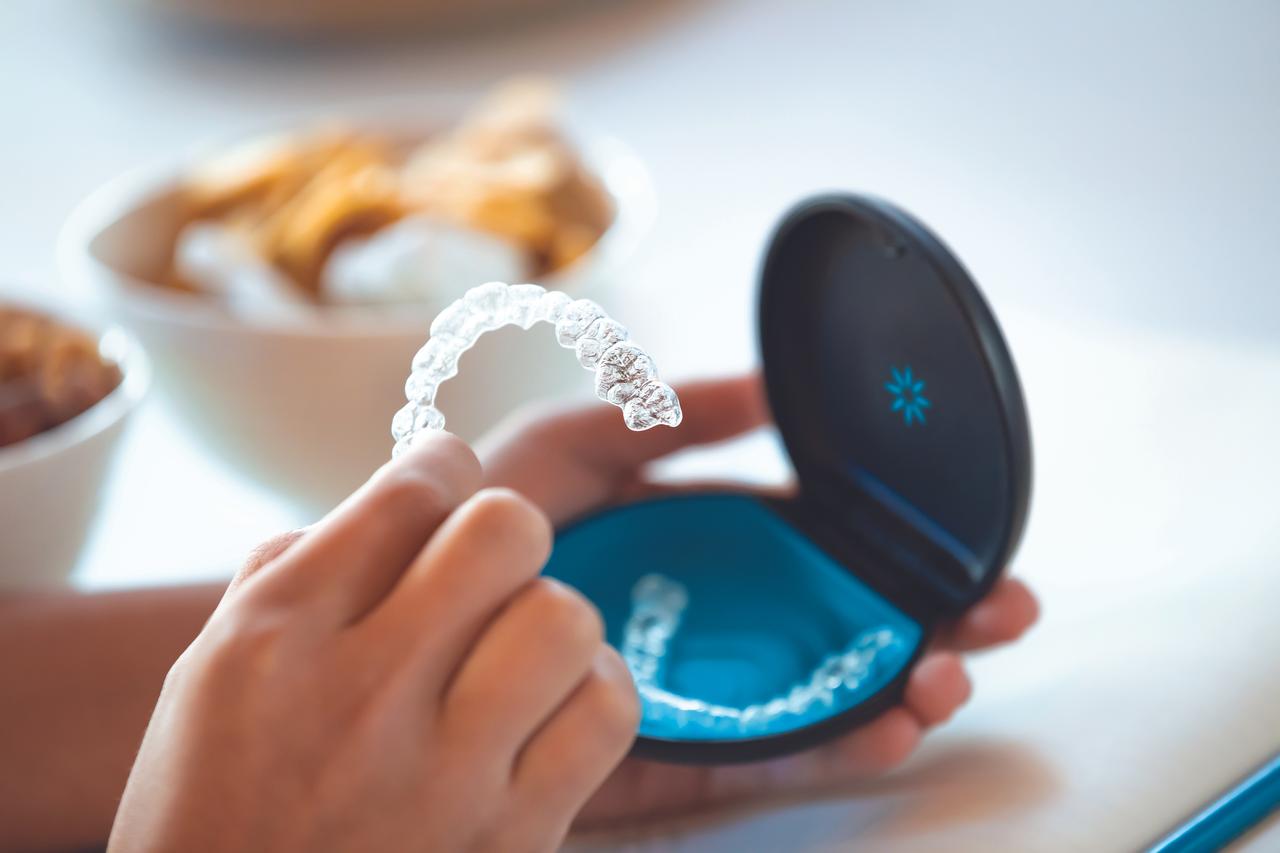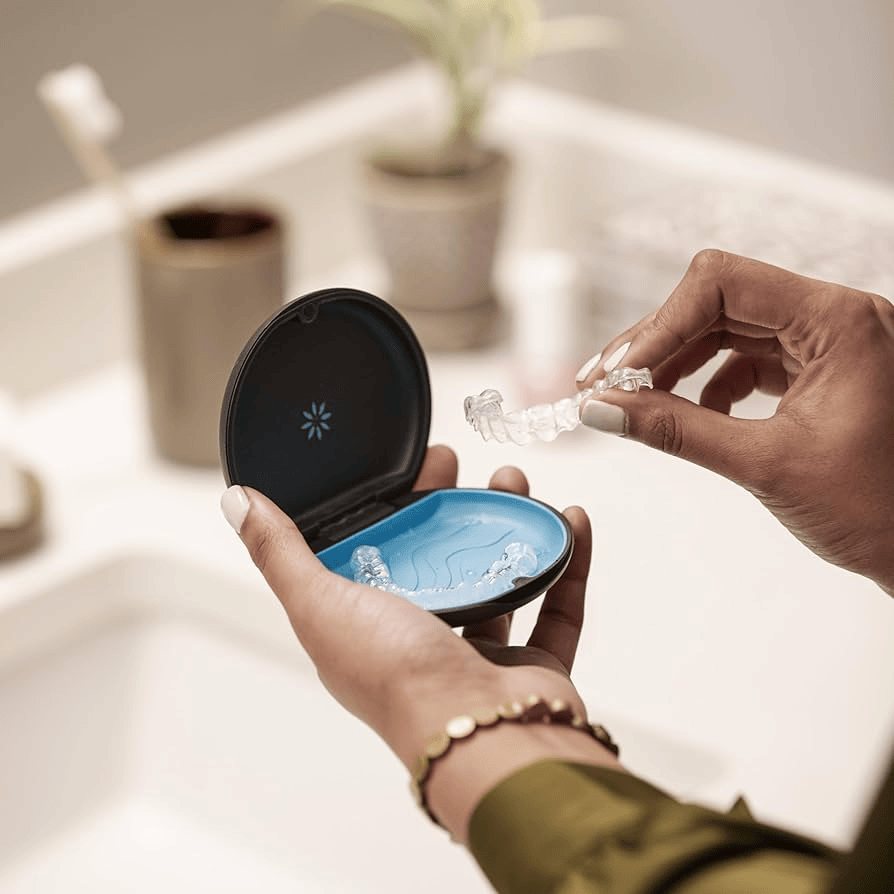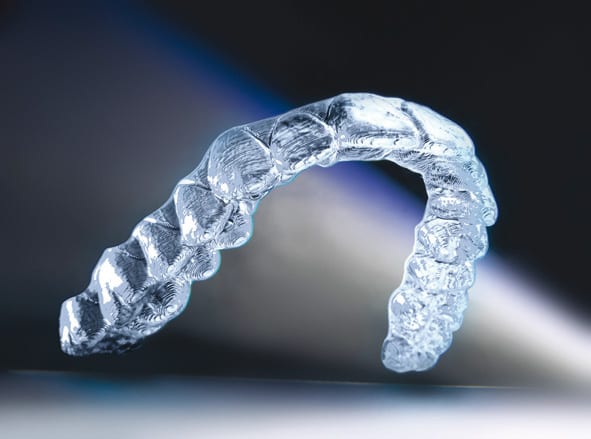One of the standout benefits of Invisalign treatment is the flexibility it offers when it comes to eating and drinking. Unlike traditional metal braces or lingual braces, which come with long lists of dietary restrictions, Invisalign clear aligners are completely removable. This means you can still enjoy your favorite foods and drinks—without worrying about damaging brackets or wires. However, it’s important to remove your aligners before consuming anything other than water. Eating or drinking with aligners in can damage the SmartTrack™ material and lead to bacterial buildup. In this guide, we’ll break down which foods and drinks are safe and how to protect your aligners for the best possible treatment results.
Table of contents
What Foods Should You Avoid with Invisalign Aligners
Why Removing Your Aligners Matters
With Invisalign, you have far more dietary freedom than with traditional braces. However, the key rule is simple: always remove your aligners before eating or drinking anything except water. This protects the aligner trays from damage and prevents staining, warping, or bacterial buildup. Once your aligners are out, you can enjoy any food you like—without worrying about breaking brackets or damaging wires. Just remember to brush and rinse your teeth before putting the aligners back in to maintain optimal oral health and hygiene.
Foods and habits to avoid while wearing aligners include:
Sticky foods like gum, caramel, and taffy
Hard or crunchy snacks such as popcorn and ice
Colored beverages like coffee, tea, or red wine while aligners are in
Smoking, which can stain and warp aligners
Do’s and Don’ts of Eating with Invisalign Aligners
Daily Best Practices for Eating
Invisalign aligners should be worn for 20 to 22 hours each day to remain effective, which means they should only be removed for meals and beverages. After eating, it’s important to brush or rinse your teeth before reinserting your aligners. This helps prevent plaque buildup and maintains the clarity of the aligner trays. Regular brushing and flossing will also help safeguard your teeth against cavities and gum disease during treatment.

Common Pitfalls to Avoid
Certain foods and drinks can damage or stain your Invisalign aligners if consumed while wearing them. Hot liquids like tea or coffee can warp the SmartTrack™ material, and sugary beverages can fuel bacterial growth. Even chewing gum or mints can interfere with the fit of the aligners. If you need a breath freshener, opt for a product like Movemints—specifically designed for Invisalign wearers.

Do’s and Don’ts of Drinking with Invisalign Aligners
While Invisalign provides dietary flexibility, beverages are a common source of accidental damage to aligners. Drinking anything other than water while wearing aligners can result in staining, warping, or increased bacteria. Hot drinks and sugary beverages should always be consumed after removing the trays, and you should rinse your mouth and your aligners before reinsertion to prevent bacterial growth. Water is always safe to consume with aligners in place—and staying hydrated is encouraged!
What To Drink and What To Avoid
When wearing your aligners, stick to plain water to avoid damage or staining. Beverages such as coffee, tea, soda, red wine, or juice should only be consumed after removing your aligners. Remember, hot drinks can warp the trays, while dark liquids and sugary drinks can stain them and promote bacteria buildup. If you do consume any of these beverages, rinse your mouth and aligners thoroughly before reinsertion.
Why Proper Cleaning Is Essential
Maintaining the cleanliness of both your teeth and your aligners is crucial throughout Invisalign treatment. Food particles and sugar residue left on your teeth or in your aligners can lead to cavities, gum disease, or plaque buildup. Make a habit of brushing, flossing, and rinsing after every meal and before putting aligners back in. Additionally, clean your aligners daily using water or an approved cleaning solution to keep them clear and odor-free.

What Happens If You Eat with Your Invisalign Aligners On?
Risks of Eating With Aligners
Eating with Invisalign aligners still in place can quickly lead to several problems. Chewing can cause the aligners to bend, crack, or lose their shape—making them less effective. Additionally, food particles can get trapped between the aligner and your teeth, increasing the risk of tooth decay and gum disease. Certain foods can also stain or permanently discolor your aligners, diminishing their clarity and appearance.
Tips for Maintaining Healthy Aligners
To protect your aligners and your oral health:
- Always remove aligners before eating or drinking anything except water
- Brush or rinse your teeth after meals and before putting aligners back in
- Avoid using aligners while chewing gum or eating mints unless using Movemints
- Clean your aligners regularly using approved cleaning solutions
Summary
Invisalign aligners offer the flexibility to enjoy your favorite foods—something that traditional braces can’t match. However, it’s essential to follow best practices to protect both your teeth and your aligners. Always remove your aligners when eating or drinking anything other than water, and maintain excellent oral hygiene to keep your treatment on track. By following these guidelines, you can enjoy the benefits of Invisalign while achieving a healthier, straighter smile.
Benefits of Removing Aligners Before Meals
Removing your aligners before eating is not only necessary to protect the trays from damage—it also promotes better oral hygiene and overall treatment success. Aligners are designed to fit snugly over your teeth and exert controlled pressure to move them into the correct position. Eating with them in place can compromise that fit and cause unintended consequences. Taking out your aligners during meals allows you to enjoy a wider variety of foods and helps ensure your treatment remains effective.
Top benefits of removing aligners before eating:
Prevents warping, cracking, or breaking of aligners
Reduces risk of staining from colorful foods or beverages
Promotes healthier teeth and gums by reducing trapped food particles
Helps maintain proper aligner fit and treatment progress
Best Practices for Cleaning Aligners and Teeth
Proper cleaning habits are critical when undergoing Invisalign treatment. Because your aligners fit tightly over your teeth, any plaque or food particles left behind can become trapped, increasing the risk of decay or gum issues. Developing a consistent cleaning routine for both your teeth and your aligners ensures that your mouth stays healthy and your aligners stay clear and odor-free.
How To Clean Invisalign Aligners Daily
Your aligners should be cleaned at least once a day—and ideally every time you remove them for meals. Use a soft toothbrush and lukewarm water to gently scrub the inside and outside of each tray. Avoid using toothpaste, which can scratch the aligner surface. Invisalign Cleaning Crystals or other approved solutions can also be used to soak the trays and remove stubborn buildup.
Daily cleaning tips for aligners:
Use lukewarm water and a soft toothbrush to clean
Avoid hot water, which can warp the aligner material
Soak aligners in Invisalign Cleaning Crystals
Store aligners in their case when not in use
How To Maintain Oral Hygiene
Maintaining excellent oral hygiene during Invisalign treatment is just as important as cleaning your aligners. Brushing your teeth after every meal and before reinserting your aligners will help prevent cavities, gum disease, and aligner staining. Flossing daily is also critical, as food particles can become trapped between teeth and underneath aligners if not removed.
Oral hygiene tips during Invisalign treatment:
Brush your teeth after every meal and snack
Floss daily to prevent buildup between teeth
Fluoride mouthwash to strengthen enamel
Visit your dentist regularly for professional cleanings
How do I survive the first week of Invisalign?
The first week of Invisalign treatment can take some getting used to, but a few simple tips will help you adjust smoothly. Choose softer foods and avoid anything too crunchy or sticky, as your teeth may be tender while adjusting to the new aligners. Gently massaging your gums and teeth can ease discomfort and improve circulation. If your aligners cause irritation along your cheeks or gums, applying dental wax to the edges can provide relief. Managing soreness with over-the-counter pain relievers or using a cold compress can also make the first few days more comfortable. Staying consistent with these habits will help you get through the adjustment period and keep your treatment on track.
Can you eat pizza with Invisalign?
You can absolutely enjoy pizza during Invisalign treatment, but only after removing your aligners. Since pizza often has chewy crusts, oily cheese, and acidic sauces, it’s important to brush your teeth thoroughly before reinserting your aligners to avoid trapping food particles or staining. Remember—never eat with your aligners in place, and always follow proper cleaning steps afterward to maintain a healthy smile.
Can I drink through a straw with Invisalign?
Drinking through a straw is a smart way to help protect your teeth and aligners when consuming anything other than water. A straw helps minimize contact between sugary, acidic, or staining drinks and both your teeth and Invisalign trays. This can help prevent staining, reduce enamel erosion, and limit the buildup of bacteria under your aligners. Just remember to remove your trays and brush if you drink anything beyond water to maintain optimal oral hygiene.
Did you lose weight on Invisalign?
Some patients do report losing a small amount of weight—often around 10 to 15 pounds—while using Invisalign, largely due to lifestyle changes. Because aligners must be worn for 20–22 hours a day, many patients find themselves snacking less frequently and drinking fewer sugary beverages. However, this is not guaranteed and should not be viewed as a primary goal of Invisalign treatment. Any weight changes that occur typically result from improved eating habits and better oral care routines adopted during orthodontic treatment.
Conclusion
Invisalign offers unmatched freedom when it comes to your diet, but maintaining proper habits is essential for treatment success. Always remove your aligners before eating or drinking anything besides water, and clean both your teeth and trays diligently to protect your oral health. With these simple precautions, you’ll keep your aligners clear, your teeth healthy, and your treatment on track—so you can enjoy both your favorite foods and a beautiful new smile.






